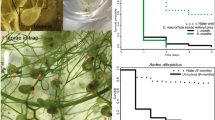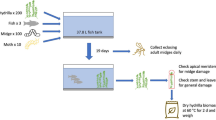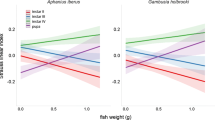Abstract
European green hydra,Chlorohydra viridissima (Pallas) were tested for adaptability and predation effectiveness in natural habitats ofAedes nigromaculis (Ludlow) andCulex tarsalis Coquillet in Kern County, California from June through December, 1973. Hydra were well adapted to all habitats except Kern River seepage where their adaptability was measured at only 55.6%.Aedes nigromaculis populations were reduced 67.2% in an irrigated pasture in July.Culex tarsalis densities were reduced 33.9% in standing Kern River seepage and 79.2% in duck club ponds from September through December, 1973. TheC. tarsalis larval density in hydra treated duck club ponds remained below an average of 0.5/dip after inoculation in September. Hydra density increased at inoculation sites and significant numbers overwintered at Riverside, California without food. The practical utilization of hydra and their attributes for mosquito control are discussed.
Résumé
L'hydre verte européenne,Chlorohydra viridissima (Pallas) a été expérimentée de juin à décembre 1973 quant à ses possibilités d'adaptation et son efficacité prédatrice dans les habitats naturels deAedes nigromaculis (Ludlow) etCulex tarsalis Coquillet dans le comté de Kern en Californie. Les hydres se sont bien adaptées à tous les habitats, sauf dans les infiltrations de la Kern River où leur adaptabilité a été évaluée à 55,6 % seulement.
Les populations deA. nigromaculis ont été réduites en juillet de 67,2% dans une prairie irriguée, celles deC. tarsalis ont été réduites de 33,9% dans des infiltrations stagnantes de la Kern River et de 79,2% de septembre à décembre 1973 dans des mares à canard. La densité des populations larvaires deC. tarsalis dans les mares à canard traitées à l'aide des hydres est restée inférieure à une moyenne de 0,5 par prélèvement après l'intervention en septembre. La densité en hydres s'est accrue dans les lieux d'introduction et des quantités significatives ont passé l'hiver sans alimentation à Riverside, Californie. L'utilisation pratique des hydres et leurs propriétés pour la lutte contre les moustiques sont discutées.
Similar content being viewed by others
References
Eakin, R. E. — 1961. Studies on chemical inhibition of regeneration in Hydra. In: Biology of Hydra. (H. M. Lenhoff & W. F. Loomis eds.). —Univ. of Miami Press, 467 p.
Hamlyn-Harris, R. — 1929. The relative value of larval destructors and the part they play in mosquito control in Queensland. —Proc. R. Soc. Queensland, 42, 23–38.
Hargreaves, E. — 1924. Entomological notes from Taranto (Italy), with reference to Faenza during 1917 & 1918. —Bull. entomol. Res., 14, 213–219.
Kanaev, I. — 1952. Ecology, physiology and reproduction of Hydra. In: Essays on the Biology of Hydra. —Soviet Acad. Sci., Moscow, 340 p. Translated byE. T. Burrows & H. M. Lenhoff. 1969. (H. M. Lenhoff ed.), 452 p. (in English).
Laird, M. — 1956. Studies of mosquitoes and freshwater ecology in the South Pacific. —R. Soc. New Zealand, Bull No. 6, 1–213.
Legner, E. F. &Medved, R. A. — 1972. Predators investigated for the biological control of mosquitoes and midges at the University of California, Riverside. —Proc. Calif. Mosq. Control. Assoc., 40, 109–111.
Lenhoff, H. M. &Brown, R. D. — 1970. Mass culture of hydra: improved method and application to other invertebrates. —Laboratory Anim., 4, 139–154.
Lenhoff, H. M. &Loomis, W. F. — 1957. Environmental factors controlling respiration in hydra. —J. exp. Zool., 134, 171–182.
Loomis, W. F. — 1964. Environmental factors controlling growth in hydra. —J. exp. Zool., 126, 223–234.
— — 1964. Microenvironmental control of sexual differentiation in hydra. —J. exp. Zool., 156, 289–306.
Loomis, W. F. &Lenhoff, H. M. — 1956. Growth and sexual differentiation of hydra in mass culture. —J. exp. Zool., 132, 555–374.
Muscatine, L. — 1961. Symbiosis in marine and fresh water Coelenterates. In: Biology of Hydra. (H. M. Lenhoff & W. F. Loomis, eds.). —Univ. of Miami Press, 467 p.
Muscatine, L. &Lenhoff, H. M. — 1965. Symbiosis of hydra and algae. I. Effects of some environmental cations on growth of symbiotic and aposymbiotic hydra. —Biol. Bull., 128, 415–424.
Qureshi, A. H. &Bay, E. C. — 1969. Some observations onHydra americana Hyman as a predator ofCulex peus Speiser mosquito larvae. —Mosq. News, 29, 465–471.
Rutherford, C. L., Hessinger, D. &Lenhoff, H. M. — 1965. Introduction of rythmic differentiation of ovaries inChlorohydra viridissima. —Am. Zool., 5, 722.
Slobodkin, L. — 1966. Experimental populations of hydra. —Anim. Ecol., suppl. 33, 131–148.
Snedecor, G. W. — 1946. Statistical Methods. —Iowa State College Press, Ames, 485 p.
Southwood, T.R.E. — 1971. Absolute population estimates by sampling a unit of freshwater habitats, In: Ecological Methods. (T.R.E. Southwood ed.). —Chapman & Hall, Lond. 391 p.
Stephanides, T. — 1960. On the influence of the hydra in mosquito control. —Praktika Hellenic. Hydrobiol. Ins., 7, 1–5.
Twinn, C. R. — 1931. Observations on some aquatic animal and plant enemies of mosquitoes. —Can. Entomol., 63, 51–61.
Yu, H. S. &Legner, E. F. — 1973. Inoculation of hydra [Coelenterata] and predation effectiveness in experimental mosquito (Culex) breeding habitats. —Proc. Calif. Mosq. Contr. Assoc., 41, 131–136.
Author information
Authors and Affiliations
Additional information
Research partially supported by grant GB-31068 of the National Science Foundation, and grants-in-aid and assistance from the Southeast Los Angeles, Orange County, and Kern Mosquito Abatement Districts, California.
Rights and permissions
About this article
Cite this article
Yu, HS., Legner, E.F. & Sjogren, R.D. Mass release effects ofchlorohydra viridissima [Coelenterata] on field populations ofAedes nigromaculis andCulex tarsalis in Kern County, California. Entomophaga 19, 409–420 (1974). https://doi.org/10.1007/BF02372775
Issue Date:
DOI: https://doi.org/10.1007/BF02372775




